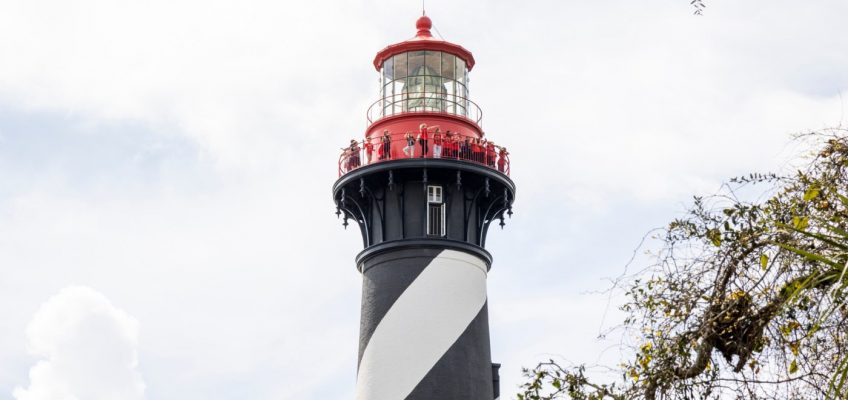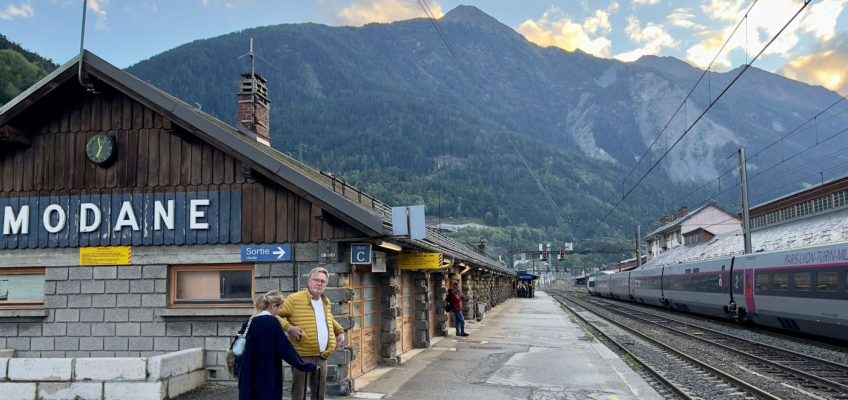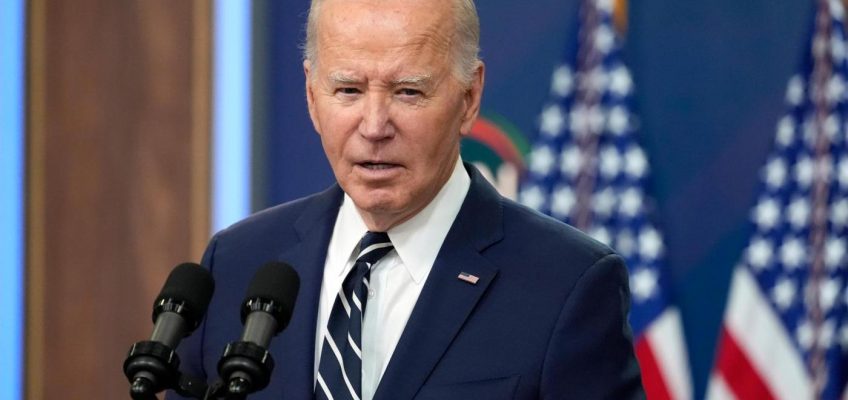The word “lighthouse” probably conjures images of idyllic beachside scenes or historic postcards that invoke a certain sense of nostalgia. They might be seen as beacons of hope to guide those in need during challenging or stormy conditions.
Every lighthouse has a story involving keepers, their families, pets and a lifestyle that could sometimes prove hard and solitary. At several lighthouses, such as Ponce Inlet and St. Augustine, it’s possible to tour keepers’ houses to be transported into the past with a simpler way of life. Other exhibits focus on Fresnel lenses, shipwrecks or the evolution of lamps from oil to electric.
While many lighthouses have been automated, eliminating the need for a full-time keeper, these historic structures serve as time capsules that take visitors into the pages of Florida history. Along different stretches of coastline, it’s possible to climb the state’s tallest lighthouse or its most haunted tower or even to stay overnight in a New England-style replica built in the 1980s.
The Ponce Inlet Lighthouse is Florida’s tallest, standing at 175 feet tall. The tower and grounds are open daily for visitors who can explore the museum’s exhibits and informational displays. (Patrick Connolly/Orlando Sentinel)
Tallest: Ponce Inlet Lighthouse
While Florida doesn’t offer mountaintop vistas and overlooks from atop high cliffs, it does have a 175-foot lighthouse at Ponce Inlet, providing visitors who climb its 203 steps with a 360-degree view of the Halifax River, the Atlantic Ocean and nearby Smyrna Dunes Park. In 1835, a 45-foot tower was constructed on the south side of what was then known as Mosquito Inlet, but it collapsed into the sea in April 1836 following strong storms. The current lighthouse, now a national historic landmark, was completed in 1887 and cost nearly $200,000 with a first-order Fresnel lens.
Modern-day guests can witness this still-working lighthouse (which now uses a third-order Fresnel lens) constructed of 1.25 million bricks and wander between three original keepers’ homes, a lens exhibit building, an oil storage building and a pump house.
It’s 203 steps up to the gallery deck at Ponce Inlet Lighthouse, Florida’s tallest, standing at 175 feet. The tower and grounds are open daily for visitors. (Patrick Connolly/Orlando Sentinel)
If you go: The Ponce Inlet Lighthouse & Museum is open daily at 10 a.m., closing hours vary by the season (6 p.m. through May 24, then 9 p.m. May 25-Sept. 2) at 4931 South Peninsula Drive in Ponce Inlet. Admission costs $6.95 per adult and $1.95 per child aged 3-11 (free for infants). Pets are not allowed except for service animals. More information: ponceinlet.org
The Amelia Island Lighthouse is Florida’s oldest existing lighthouse. (Patrick Connolly/Orlando Sentinel)
Oldest: Amelia Island Lighthouse
It might not tower over the landscape (at only 67 feet tall) or appear particularly impressive at first glance, but the Amelia Island Lighthouse has a few unique claims of fame. In addition to being the Sunshine State’s oldest existing lighthouse, it’s also the westernmost lighthouse on the east coast of the United States. When the lantern was taken down from Cumberland Island, moved to Amelia Island and illuminated in 1839, Florida wasn’t yet a state.
The lighthouse isn’t open for visitors to climb, but tours are available on the first and third Wednesdays of each month. In addition, the surrounding property is open for public viewing on Saturdays.
If you go: The Amelia Island Lighthouse grounds are open from 11 a.m.-2 p.m. on Saturdays, with tours available on select dates for $10 per adult and $5 per child at 215 O’Hagan Lane in Fernandina Beach. Views of the lighthouse are also available from nearby Fort Clinch State Park. More information: fbfl.us
The St. Augustine Lighthouse glows in the nighttime as seen from Anastasia State Park. (Patrick Connolly/Orlando Sentinel)
Most Haunted: St. Augustine Lighthouse
America’s oldest city, which celebrated its 450th anniversary several years ago, has a storied past that includes Indigenous people, Spanish colonists and a brief British occupation. Long before the current St. Augustine Lighthouse was constructed, a Spanish watchtower sat closer to the ocean, evolving to meet security and navigation needs. When it became evident that the first lighthouse tower was doomed to fall into the sea, a new 165-foot tower was constructed beginning in 1871. It remains as St. Augustine’s first and oldest surviving brick structure.
Though the tower and keepers’ house have received major restoration work in recent decades, the tower modern-day guests can climb is the same one that has stood for nearly 150 years. With such a long history, there are rumored to be ghosts of young sisters who died on the property and the spirit of a keeper who fell to his death while painting the outside of the tower. Try to spot these spirits who haunt the grounds during nighttime ghost tours.
The St. Augustine Lighthouse is open for visitors daily. Guests can opt to climb 219 steps to the top observation deck to see a first-order Fresnel lens that stands 9 feet tall. (Patrick Connolly/Orlando Sentinel)
If you go: The St. Augustine Lighthouse & Maritime Museum is open daily from 9 a.m.-6 p.m. at 100 Red Cox Drive in St. Augustine. The grounds also include museum exhibits in four historic structures, a children’s play area and Heritage Boatworks, where volunteer boatwrights build small craft using historic techniques. Admission is $14.95 per adult and $12.95 for seniors ages 60 and older and children younger than 12 (who must be at least 44 inches tall to climb the tower). Tours cost extra. Animals are welcome on the grounds but not in the historic buildings. More information: staugustinelighthouse.org
Unique Overnight: Katie’s Light
While most lighthouses give daytime visitors a glimpse into what life was like for keepers living and working in the 19th and 20th centuries, one gives guests the chance to stay overnight on Amelia Island. Katie’s Light, named for the deceased daughter of hoteliers David and Susan Caples, is a 1980s replica of Maryland’s Thomas Point Shoal Lighthouse. Beth Anne Caples, the couple’s other daughter, and her husband, William Kaner, gave the vacation rental property a facelift in recent years but stuck to the historic, seafaring character of the house. Though prices vary, it costs an average of $783 per night to stay in this three-bedroom, 2.5-bathroom beachfront abode, complete with a wrap-around deck and a central spiral staircase inside.
If you go: Visit katieslight.com to find booking links on Airbnb and Vrbo for the property in Fernandina Beach on Amelia Island.
Aerial photos from March 1, 2023, show Sanibel Island five months after Hurricane Ian, which made landfall in late September 2022. While the Sanibel Lighthouse lost a leg in the storm, it has since received a new one and is undergoing exterior restoration work. (Patrick Connolly/Orlando Sentinel)
Most Resilient: Sanibel Lighthouse
Hurricane Ian, which ravaged the coast of Southwest Florida in September 2022, is forever etched into the minds of Sanibel Island’s residents and the community’s collective history. In a remarkable show of resilience, the Sanibel Lighthouse lost a leg during the catastrophic storm but remained standing, shining once again five months after the storm. Though the surrounding keepers’ cottages and buildings were leveled in Ian’s rage, the lighthouse now has a new leg and is undergoing a restoration project with a new exterior paint job.
If you go: Lighthouse Beach Park on the southern tip of Sanibel Island is open from dawn to dusk daily. Parking is $5 per hour. The lighthouse tower is not open to the public for climbing or tours.
Best Comeback: Alligator Reef Lighthouse
Though Alligator Reef might sound like a menacing place to pull up on a boat for lunch, it’s situated in the Florida Keys where there aren’t many alligators. The lighthouse is named after the USS Alligator, a U.S. Navy schooner that ran aground on the reef in 1822 and sank. The lighthouse was dark for about 10 years and then illuminated again in 2023 with solar-powered lights as an Islamorada community group is spending $6 million on a restoration and preservation project.
If you go: The Alligator Reef Lighthouse is located about five nautical miles off the coast of Islamorada and is only accessible by boat.
A restored lighthouse built in 1887 is the main focal point at Anclote Key Preserve State Park. (Patrick Connolly/Orlando Sentinel)
Off-grid Oasis: Anclote Key Lighthouse
This national historic landmark is situated a few miles west of Tarpon Springs on state park land along Florida’s Gulf Coast. Although the lighthouse was battered by Hurricane Idalia, which tore through the Big Bend region of the state in late August 2023, it recently received an $800,000 facelift, including a fresh coat of paint inside and out. The cast iron structure with a supportive exoskeleton was constructed similarly to the Sanibel Lighthouse. An off-grid residence sits just north of the tower where a ranger lives full-time and uses reverse osmosis to make freshwater from saltwater. The lighthouse is solar-powered.
If you go: The Anclote Key lighthouse, situated about three miles west of Tarpon Springs on the Gulf Coast, has open houses for visitors to climb the tower during the second weekend of each month November-May (not during summer months). Boaters can see the lighthouse and visit the island, which has no amenities, from dawn to dusk daily. Primitive camping is available on the north end of Anclote Key. Alcohol and dogs are prohibited on the island; shoes are encouraged. More information: anclotecso.org or floridastateparks.org
A stroller walks by the Mount Dora Lighthouse as the sun sets on Lake Dora in Mount Dora. (Stephen M. Dowell/Orlando Sentinel)
Most Inland: Mount Dora Lighthouse
Visitors to Mount Dora, a quaint Central Florida city with plenty of small-town charm, might be surprised to see a lighthouse so far from the coast. At Grantham Point Park, next to the Mount Dora Marina, take a walk around the 35-foot lighthouse and Florida’s only inland navigation aid. It illuminates at night to help boaters on Lake Dora after dusk.
If you go: Grantham Point Park or “Lighthouse Park” is open daily at 311 S. Tremain St. in Mount Dora. More information: whattodoinmtdora.com
Rain clouds skirt the coast at the Cape Canaveral Lighthouse at Cape Canaveral Space Force Station during a media open house March 3, 2021. The lighthouse is open to public tours on select dates by appointment for U.S. citizens only due to its ownership by the U.S. Space Force. (Joe Burbank/Orlando Sentinel)
Citizens Only: Cape Canaveral
Owned by the United States Space Force and maintained by the U.S. Coast Guard, the Cape Canaveral Lighthouse has stood for more than 150 years, now located on an active military installation. Canaveral Tours offers shuttles to the lighthouse and tours since visitors cannot drive their vehicles onto the base. Only U.S. citizens who go through security clearances are allowed access to the lighthouse due to Department of Defense restrictions.
If you go: Visit canaverallight.org for more visitor information.
Find me @PConnPie on Instagram or send me an email: pconnolly@orlandosentinel.com.
The St. Marks Lighthouse is the oldest lighthouse on Florida’s Gulf Coast located in the St. Marks National Wildlife Refuge. (Richard Tribou/Orlando Sentinel)
Other Florida Lighthouses Open to the Public (From the Gulf Coast to the Atlantic Coast)
Pensacola Lighthouse
Cape San Blas Lighthouse
Cape St. George Light
Crooked River Lighthouse
St. Marks Lighthouse
Cedar Key (Seahorse Key) Lighthouse
Port Boca Grande (Gasparilla Island) Lighthouse
Key West Lighthouse
Cape Florida (Key Biscayne) Lighthouse
Jupiter Inlet Lighthouse
The Ponce Inlet Lighthouse and Museum are open daily. One building houses Fresnel lenses in an informational exhibit. (Patrick Connolly/Orlando Sentinel)
Lighthouse 101
In the late 1800s and early 1900s, lighthouse keepers were responsible for hauling 40 lbs. of kerosene or whale oil up to the top of the tower each evening. Keepers would also be responsible for cleaning the lens, lamp and tower, plus managing every aspect of the light station. This could include first aid, repairs, tending buoys and daily logs of activities.
Iron braziers and candle chandeliers were once used to illuminate lighthouses before oil lamps and reflectors were implemented to amplify the light output.
In 1814, French physicist Augustin-Jean Fresnel made a breakthrough in lighthouse illumination by pioneering a lens that used glass prisms to focus rays of light to shine in a specific direction. These are classified from first-order through sixth-order, from largest to smallest. First-order lenses can stand 10-11 feet tall and cast light that can be seen for up to 22 nautical miles.
In 1789, the U.S. Lighthouse Establishment was created to allow for federal oversight of aids to navigation. In 1852, U.S. Congress passed legislation to create a U.S. Lighthouse Board to modernize lighthouses with Fresnel lenses and standardized procedures. By 1910, there were 11,713 aids to navigation of all types in the country, during the same year when the Bureau of Lighthouses was created and operated as the U.S. Lighthouse Service.
A “daymark” refers to a unique paint pattern on each lighthouse tower to help identify one’s location on the coast. A “nightmark” is a distinctive flash pattern of the light at night.
Find me @PConnPie on Instagram or send me an email: pconnolly@orlandosentinel.com.




